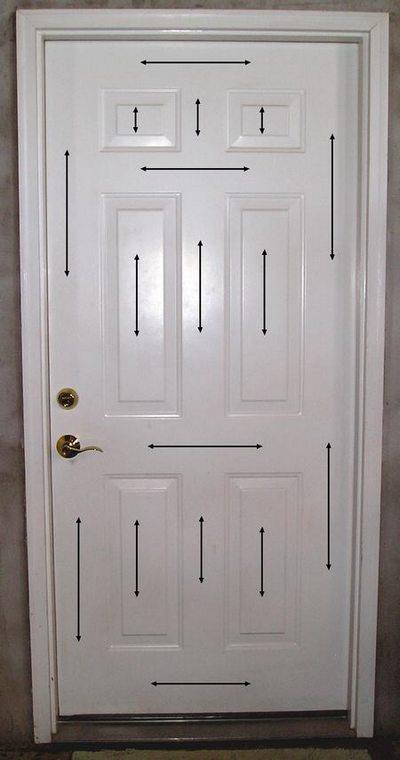If it hardens completely, sand it smooth. Sand all surface areas with the grain using 100-grit paper. To make sure no bits of dust mar the finish, vacuum the cabinets inside and out, then rub them down with a tack fabric to catch any particles that the vacuum misses out on. Dee says, "Hand sanding is the finest method on oak because you can push the paper into the open grain, which a power sander or sanding block will miss out on. Cabinet Painting 28214." When using a tack cloth, unfold each brand-new cloth totally, down to one layer, then fold it to get the greatest dust collection surface.
But they just sink into open-grained woods such as oak, ash, mahogany, or hickory. Brushing putty, the pudding-thick, oil-based finishing Dee used on these oak cabinets, fills the grain as it primes the wood. A number of cautions: It needs to be used with a good-quality nylon-polyester brush, which you'll need to throw away after each coat.

Beginning at the top of the cabinet, brush on the primer or brushing putty throughout the grain, then "tip off" pass the brush gently over the wet finish in the direction of the grain (Cabinet Painting Contractors 28204). Constantly tip off in a single stroke from one end to the other. Give it a day to dry.

Sand any profiled surfaces with a medium-grit sanding sponge. When you're done, whatever needs to be glass-smooth. Follow the underlying structure of the cabinet or door with the brush. Where a rail (horizontal piece) butts into a stile (vertical piece), for circumstances, paint the rail first, overlapping slightly onto the stile.
Painting Kitchen Cabinets: Kitchen Cabinet Painters 28204 Cabinet Depot Can Cabinet Painters 28203 Be Fun For Cabinet Painting 28212 Anyone
Where a stile butts into a rail, paint the stile first. Squeeze a thin bead of latex caulk into any open seams. Pull the idea as you go, then smooth the caulk with a damp finger. Fill any little damages, scratches, or dings with vinyl spackle, smoothed flat with a putty knife.
Spot-prime the spackle, and any spots where the brushed-on guide is "burned through," with a spray can of fast-drying oil-based primer. Wait an hour, then sand the primer gently with 280-grit paper. Vacuum all surfaces, and clean with a tack cloth. The hole in a caulk tube's tip should be no bigger than the idea of a sharp pencil.
Work from leading to bottom, using the paint throughout the grain, then tipping it off with the grain. For cabinet interiors, use the paint with a smooth-surface mini roller, which leaves a slight orange-peel texture. Sand all surfaces with 280-grit paper, then vacuum and clean with tack fabric. Cabinet Painting 28226. For the last coat, break out a brand-new brush.
Brushes select up dust, so always put paint into a different container to avoid contamination of the paint in the can. If any paint is left over, put it back into the can just through a fine-mesh strainer. The technique for prepping and painting doors, drawers, and shelves is the same as on the cabinets, other than that all the work is done on a table to minimize the chance of drips, runs, and droops. Cabinet Painting Contractors.
The Best Strategy To Use For How To Paint Kitchen Cabinets - Bob Vila
Follow the exact same preparation series as for cabinetsclean with deglosser, fill the holes, sand, vac, and tackand the very same priming sequence: in this case, two coats of brushing putty. Smooth the flat surfaces on the panel and the frame with a random-orbit sander. On bevels or profiles, apply effort and a medium-grit sanding sponge.

When priming or painting paneled doors, brush in the following sequence to get the best-looking surface in the least amount of time: begin with the location around the panel, then do the main field of the panel, then end up with the stiles and rails around the edges. As you go, clean up any paint that winds up on surrounding dry surface areas. Cabinet Painting.

After vacuuming and tacking all the surfaces, spray a fast-dry guide on any spots with spackle or bare wood where the sandpaper "burned through" the primer. Wait an hour prior to sanding - Cabinet Painters Charlotte NC. Get rid of all dustfirst with a vacuum, then with a tack clothand use the surface coat. Tip it off with the grain.
Vacuum and tack every piece, then brush on the final coat. To prevent drips on outside edges, pull the brush towards them. To prevent drips in corners, first discharge the brush by removing the paint, then paint by pulling the brush away from the corner. If a drip laps onto a dry surface, wipe it up instantly.
How How To Paint Cabinets Without Brush Strokes - Home Guides ... can Save You Time, Stress, and Money.
John Dee, a perfectionist, chooses to do one side at a time, keeping the faces flat so they don't get runs. But that's two days of drying time per doorone day per side. Here's his approach for painting both sides in a day. Twist 2 screw hooks into holes drilled in an inconspicuous door edge (the lower edge for bottom cabinets, the upper edge for leading cabinets).